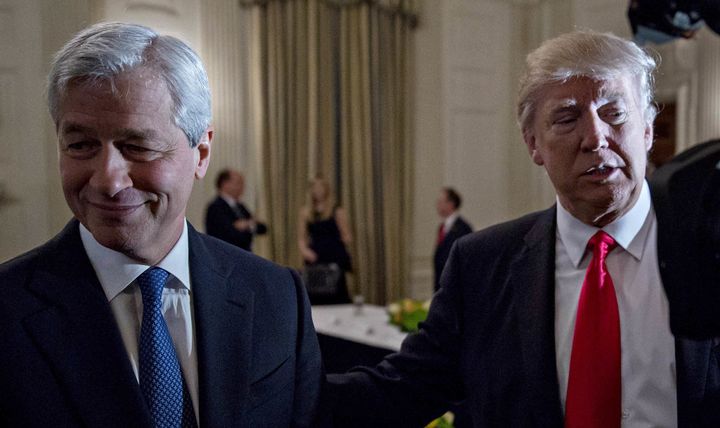
WASHINGTON ― The Republican Party has been allied with Wall Street since the presidency of William Howard Taft. So its official 2016 policy platform was more than a little startling. Discarding decades of orthodoxy, President Donald Trump’s campaign called to reinstate Glass-Steagall, a Depression-era law crafted by Democrats that would force the break-up of the nation’s six largest banks.
Trump’s advisers were wielding a devious, wonky cudgel. Hillary Clinton’s lucrative speeches to Goldman Sachs and other big banks were not sitting well with Democrats, Republicans or her own staff. Her husband had delivered the killing blow to Glass-Steagall in 1999 by granting his signature to a bill repealing the law ― a move widely blamed for fueling the 2008 financial crisis. By pledging to resurrect Glass-Steagall, Trump was positioning Republicans as populist crusaders for working people, shoving Democrats across the wrong side of the line in the ideological battle against the Washington-Wall Street axis voters held responsible for the Great Recession.
Combined with trade rhetoric cribbed from populist Democrats (and strong doses of flagrant racism), Trump’s messaging delivered. Working class voters came out in droves for a New York City billionaire who literally seated himself on a golden throne at the Republican National Convention.
Glass-Steagall was a blunt, effective instrument in its day. The law prohibited banks that accept deposits and make loans from placing bets in the much riskier securities markets. It was originally designed to end conflicts of interest that had allowed large firms to rip off their clients in the run-up to the 1929 stock market crash. But the law ultimately served a stronger purpose due to the advent of federal deposit insurance. Since the government guarantees depositors can’t lose their money in a bank failure, deposits function as an especially cheap source of funding for banks. Glass-Steagall prevented this funding from flowing to hot, high-flying speculation. This not only protected taxpayers from having to bail out bad bets, it discouraged excessive risk-taking by making it more expensive.
When Glass-Steagall was repealed in 1999, banks went on a merger binge, linking up with hedge funds, insurance companies, investment banks and private equity firms to create the unwieldy, unmanageable conglomerates that toppled in 2008. Bringing the law back would force Goldman Sachs, JPMorgan Chase, Morgan Stanley, Wells Fargo, Bank of America and Citigroup to split into several smaller firms. It would be much stronger medicine than anything implemented under former President Barack Obama’s 2010 financial reform law, known as Dodd-Frank.
The Trump clarion call for Glass-Steagall was in ideological tension with another plank of the GOP platform that demanded the repeal of Dodd-Frank, which it derided as a “legislative Godzilla” that was “crushing small and community banks.” Different factions of the party had essentially opposite views about Wall Street, with one calling for much stricter regulation and another seeking to aggressively deregulate.
But the two goals are ultimately compatible. Republicans had stumbled into a compromise policy that would repeal Dodd-Frank and replace it with Glass-Steagall. And unlike repealing and replacing Obamacare, the replacement for Wall Street was both workable and available. Sens. Elizabeth Warren (D-Mass.) and John McCain (R-Ariz.) had carefully crafted a new Glass-Steagall bill that could be voted on at any time.
But since inauguration day, Trump has been all repeal and no replace. He has packed his administration with Goldman Sachs alums and foreclosure maestros. He has celebrated banking and private equity CEOs at the White House, and signed an executive order to begin unwinding Dodd-Frank. He has sent every executive branch signal possible that he does not want agencies to aggressively enforce the regulations currently on the books, and raised prices on mortgages for first-time homebuyers just for good measure.
On Thursday, Trump spokesman Sean Spicer opened his press briefing with a paean to small banks, bemoaning their regulatory burden.
“Since 2008, the number of small banks has declined 30 percent,” Spicer declared. “The dramatic increase in regulation following the financial crisis has been a major driving force in the decline of these banks. Dodd-Frank alone has resulted in 22,000 pages of new regulations.”
This was nonsense. Community banks aren’t failing because they have to spend $98,000 a year on a new compliance officer ― they’re just being bought out by bigger banks as part of a broader national merger wave. The horror, the horror of small bank owners agreeing to receive large sums of money.
But Spicer’s speech prompted an obvious question from a reporter in the briefing room: “Candidate Trump campaigned hard on restoring the Glass-Steagall Act ... is repeal of Glass-Steagall on his agenda?”
Spicer danced around over the fact that the administration has not met with Sen. Bernie Sanders (I-Vt.), who also ran for president pledging to implement Glass-Steagall, before insisting that, “yes,” Trump remains committed to bringing the law back.
Don’t hold your breath.
CORRECTION: This piece initially identified John McCain as a Democrat. He is a Republican.
